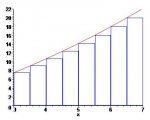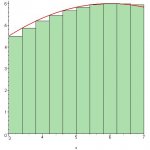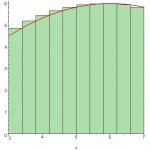They are asking for the area. If it's true that they want "the" area, then Galactus set it up nicely, for you.
If they've actually given you a fixed number of rectangles to work with, then you are looking for "an" area, and it will be an estimate of the area underneath F(x), from x = 3 to x = 7.
Start by finding the height of each rectangle (i.e., the value of F(x), where x is located at the lower-left corner of each rectangle).
Looking all over at internet tutorials and my notes but still no luck on solving.
Try searching on keywords lesson left-endpoint riemann sum at Google. They have about 1,740 references.
More importantly, study what you see (in your notes and "all over" the Internet). I can't believe that you don't have any specific questions, for us. Yet, you've asked zero questions about your notes or lessons.



